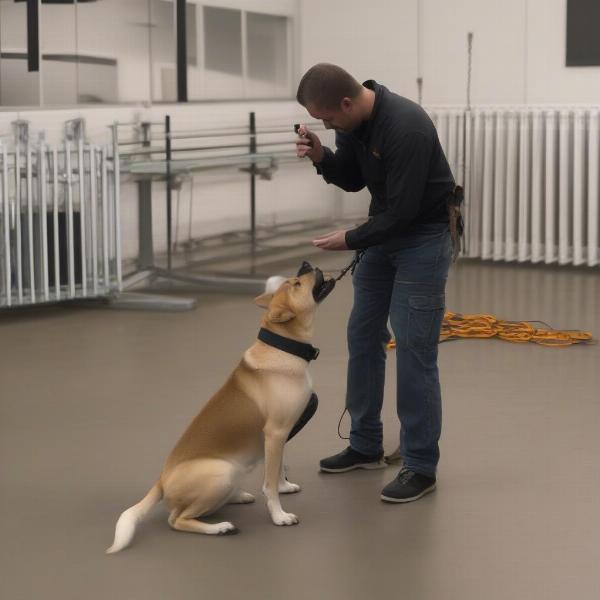E collars for dogs, also known as electronic collars or e-collars, are training tools that use electrical stimulation to modify a dog’s behavior. While they can be effective, their use is often debated. Understanding how these collars work, their proper usage, and potential risks are crucial for responsible dog ownership. This guide will provide you with the information you need to make informed decisions about using an e collar for your dog.
Types of E Collars and Their Uses
E-collars come in various forms, each designed for a specific purpose:
- Remote Training Collars: These collars are the most versatile and are used for general obedience training. They allow the handler to deliver a stimulation from a distance, reinforcing commands like “come,” “sit,” or “stay.”
- Bark Collars: Designed to curb excessive barking, these collars automatically deliver a stimulation when the dog barks. Some models use vibrations or citronella spray instead of electrical stimulation.
- Containment System Collars: These collars create an invisible fence around a designated area. The dog receives a warning signal as it approaches the boundary, followed by a stimulation if it crosses.
- GPS Tracking Collars: While not strictly e-collars, these devices often incorporate a stimulation feature for training purposes. Their primary function is to track the dog’s location, which can be invaluable for hunting dogs or dogs prone to wandering.
Choosing the Right E Collar
Selecting the appropriate e collar depends on your dog’s size, breed, temperament, and the specific behavioral issue you’re addressing. A collar that’s too powerful can be harmful, while one that’s too weak will be ineffective.
Using E Collars Responsibly
E-collars should be used as a last resort, after positive reinforcement methods have been explored. It’s essential to prioritize your dog’s well-being and avoid using the collar to inflict pain or punishment.
- Consult a Professional: Before using an e collar, seek guidance from a certified professional dog trainer or veterinary behaviorist. They can help you choose the right collar, develop a training plan, and teach you how to use the collar safely and effectively.
- Start with the Lowest Setting: Begin with the lowest stimulation level that elicits a noticeable response from your dog, such as a slight head turn or ear twitch. Gradually increase the intensity only if necessary.
- Pair Stimulation with Positive Reinforcement: Always combine the use of the e collar with positive reinforcement techniques, such as praise, treats, and toys. This helps the dog associate the desired behavior with a positive outcome.
- Monitor Your Dog’s Reaction: Observe your dog closely for any signs of distress or discomfort. If your dog exhibits fear, anxiety, or aggression, discontinue use immediately and consult a professional.
Potential Risks and Side Effects
While e collars can be effective when used correctly, there are potential risks to be aware of:
- Physical Harm: Incorrect usage can cause burns, skin irritation, and tissue damage.
- Psychological Distress: Overuse or misuse can lead to fear, anxiety, and aggression.
- Behavioral Problems: Improper training with an e collar can worsen existing behavioral issues or create new ones.
“E-collars are powerful tools that require responsible handling. Used incorrectly, they can do more harm than good,” says Dr. Emily Carter, DVM, a certified veterinary behaviorist. “Always prioritize positive reinforcement methods and consult with a professional before using an e collar.”
Are E Collars Right for My Dog?
Deciding whether or not to use an e collar is a personal choice. Carefully weigh the potential benefits and risks, and consider your dog’s individual needs and temperament.
 Dog Training with an E-Collar
Dog Training with an E-Collar
Conclusion
E collars for dogs can be a useful training tool when used responsibly and under the guidance of a professional. However, it’s crucial to understand the potential risks and prioritize your dog’s well-being. By choosing the right collar, using it correctly, and combining it with positive reinforcement techniques, you can maximize its effectiveness while minimizing the potential for harm.
FAQ
- Are e collars cruel? When used correctly, e collars are not inherently cruel. However, misuse can cause pain and distress.
- Can I use an e collar on a puppy? It’s generally not recommended to use e collars on puppies younger than six months.
- What is the best e collar for aggressive dogs? Consult with a professional dog trainer or behaviorist to determine the appropriate collar and training approach for an aggressive dog.
- How long does it take to train a dog with an e collar? Training time varies depending on the dog, the behavior being addressed, and the consistency of training.
- Are there any alternatives to e collars? Yes, positive reinforcement methods, such as clicker training, are often effective and humane alternatives.
- Can e collars cause long-term damage? Misuse or overuse can lead to physical and psychological harm.
- Where can I find a qualified trainer to help me use an e collar? Contact a certified professional dog trainer or veterinary behaviorist in your area.
ILM Dog is a leading international website dedicated to providing dog owners with expert advice and resources on all aspects of dog care, from breed selection and health to training, nutrition, and grooming. We offer a wealth of information to help you provide the best possible care for your canine companion. For personalized advice and guidance, contact us at [email protected] or call us at +44 20-3965-8624. ILM Dog is here to support you every step of the way on your dog ownership journey.